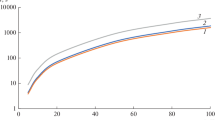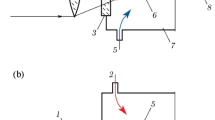Transmission spectra were measured and absorption coefficients were determined for gas condensate and oil using laser radiation with wavelength 1.07 μm. The dependences of the reflection coefficient on the laser-radiation angle of incidence on the surface of oil, gas condensate, and diesel fuel were obtained. Threshold intensities of laser radiation providing stable ignition and subsequent self-sustaining combustion of hydrocarbons on water and ice surfaces were experimentally determined. Laser afterburning (scanning) of heavy oil fractions remaining on the water surface after self-sustaining combustion was performed for the first time.




Similar content being viewed by others
References
S. V. Leshchev, “Social ecology interfaces: From technological convergence to the internet of things,” Filos. Nauki, No. 11, 103–111 (2014).
S. Ross, A Review of Countermeasures for a Major Oil Spill from a Vessel in Arctic Waters, Environmental Protection Service, Canada (1983), 73 pp.
G. A. Askar’yan, E. K. Karlova, R. P. Petrov, and V. B. Studenov, “The action of high-power laser beam on water surface with thin film of liquid: Selective evaporation, combustion and splashing of layer covering water surface,” Pis′ma Zh. Eksp. Teor. Fiz., 18, No. 11, 665–667 (1973).
A. I. Kutsenko, V. A. Gurashvili, A. G. Krasyukov, et al., “Cleaning of water surface from oil film by laser radiation,” in: Proceedings of the International Conference “Laser 96” [in Russian], Portland, Oregon, USA (1996).
V. A. Gurashvili, F. K. Kosyrev, V. F. Sharkov, et al., RU Pat. No. 1,702,872, IPC E02B17/00, “Method for cleaning water surface from petroleum oil products,” March 20, 1995.
P. D. Zhuravlev, “Use of gas-dynamic laser to clean water surface from oil pollution,” Candidate Dissertation in Technical Sciences, Moscow (2002), 75 pp.
Acknowledgments
We thank A. G. Ishkov (Gazprom Co.) and N. A. Boyarchuk and N. B. Pystina (Gasprom VNIIGAZ Ltd.) for assistance with the experimental studies and determination of the efficiency of the laser method for removing accidental oil spills.
Author information
Authors and Affiliations
Corresponding author
Additional information
V. G. Vostrikov and P. A. Svotin are deceased.
Translated from Khimicheskoe i Neftegazovoe Mashinostroenie, Vol. 56, No. 9, pp. 36–39, September, 2020.
Rights and permissions
About this article
Cite this article
Gvozdev, S.V., Dubrovskiy, V.Y., Romanov, R.E. et al. Remote Laser Burning of Liquid Hydrocarbons on Water and Ice Surfaces. Chem Petrol Eng 56, 755–760 (2021). https://doi.org/10.1007/s10556-021-00838-8
Published:
Issue Date:
DOI: https://doi.org/10.1007/s10556-021-00838-8




